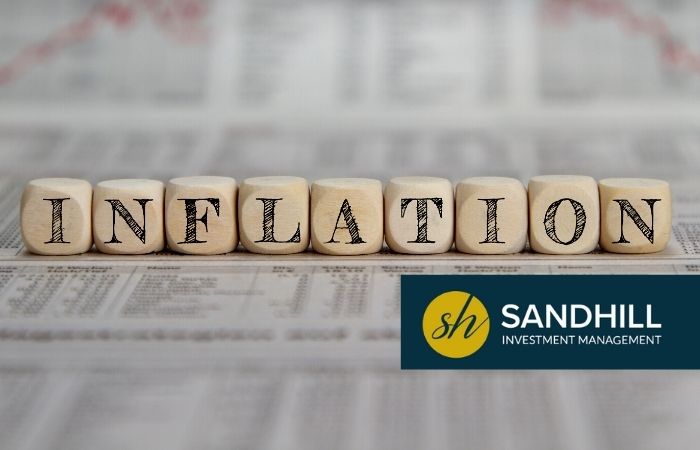This post was written by Christian Martinez, CERTIFIED FINANCIAL PLANNER™, Advisor Associate of Sandhill Investment Management
As we continue to return to pre-pandemic normalcy, there have been several pressures on our economy.
While the world gets back to full speed, inflation has been a pressing topic on the minds of investors over the past few months.
The Chairman of The Federal Reserve, Jerome Powell, has repeatedly stated that he believes that the current inflationary state that we are in is “transitory” and that the U.S will return to normal levels (around 2%) over the next few months. There are some reasons to think that this is true. U.S. inflation rose to 5% over the 12 months ending in May, which was the highest increase since the financial crisis of 2008.
Many bankers say that this huge rise in inflation is temporary because of the “whiplash” effect of the pandemic. Supply chains in almost every industry are under immense pressure from disintegrating demand when we were in the thick of the pandemic, to then surging back as we all try to return to life as normal. Lumber has been the most talked about increase in the commodity space experiencing a year-over-year increase of 154.3% as of last month. Prices for copper, steel, oil, microchips, and used cars have also sharply risen.
In tandem with the commodity inflation discussed above, the U.S. is experiencing wage inflation, as well. Businesses are trying to get back to full operating capacity, but many people are not returning to the work force. Some companies are even offering bonuses
just for interviewing for a position, and hourly pay has increased 9% since last year. Some say this is being caused by the disincentive created by the extension of the extra federal unemployment benefits, and others say that people are afraid to return to work because of the health risks attributed to COVID-19. No matter the case, this is a problem for companies.
The combination of commodity inflation and wage inflation sometimes leads to an economic phenomenon called “wage-price spiral.” This occurs when higher wages stimulate more spending growth that strains production capacity and drives up business costs. In turn, companies raise prices and workers demand even larger pay increases to stay ahead of a rising cost of living.
Wage-price spiral last occurred in the 1970s and early 1980s, when the stock market lost 50% over a 20-month period, interest rates were raised to nearly 20%, and people were priced out of new cars and homes. At the time, “The Great Inflation,” was blamed on high oil prices, speculation on currencies, unions, and greedy corporate leaders. In hindsight, we now know that irresponsible monetary policy pushed by politicians was the principal cause. The Fed has announced that there will be two or three rate hikes to combat inflation in 2023, although some say they will need to come sooner.
How do you strategically invest when there is inflation?
One of the most popular investment strategies in recent years has been “passive investing” by buying index funds or ETFs (exchange traded funds). This is an easy and inexpensive way to gain exposure to the markets to help grow your portfolio, especially when the market is good and has many tailwinds (like falling or low interest rates). While there are advantages to passive investing, the downsides are:
- Overdiversification: you own some great companies, but also the average and below-average ones
- The fund manager (if there is one) rarely rebalances the fund
- Risk management is minimal
The alternative to passive investing is active management. This is when a professional investment advisor carefully selects each security within a portfolio and can take advantage of any environment (even an inflationary one). A few of the benefits of active management are:
- Concentrated diversification- holding relatively few meticulously chosen companies
- The fund manager can make opportunistic rebalancing decisions on the fly
- Complete risk management
At Sandhill Investment Management, we are active managers. Our investment team identifies high-growth companies with high recurring revenue, strong balance sheets, and all-star management teams. We continuously monitor portfolios and search for new
opportunities.
There are winners in every environment, and it is about anticipating what will happen next and doing the necessary homework to find the companies that will stand to benefit. An active, concentrated approach to investing can have a much higher likelihood of finding those winners than riding a passive index fund or an ETF.
If you would like to discuss the above in greater detail or have any questions about Sandhill Investment Management, please reach out using the link here.
This material has been prepared for general informational purposes only and is not intended to provide — and should not be relied on for — investment, tax, legal or accounting advice for the reader. You should consult your own tax, legal and accounting advisors before engaging in any transaction. The information that has been discussed has been obtained from sources believed to be accurate; however, Sandhill Investment Management makes no guarantee as to the accuracy or completeness of the information.

This post was written by Christian Martinez, CERTIFIED FINANCIAL PLANNER™, Advisor Associate of Sandhill Investment Management, a Buffalo-based investment management firm. Since Sandhill’s inception in 2004, our passion for research has been our defining strength. By taking a thoughtful, thematic approach to the investment process, we are able to identify opportunities that offer the greatest combination of value and quality. Our deep commitment to our clients is at the forefront of everything we do. We understand that everyone’s situation is unique, and our range of investment products is carefully designed to ensure we are able to align expectations with execution.
Christian is a CERTIFIED FINANCIAL PLANNER™ and has been with Sandhill for over two years. He is passionate about creating a one-of-a-kind experience for his clients. Christian serves as a member of the Convergence Council at the Albright-Knox Art Gallery and sits on the Alumni Board of Governors at Canisius High School. He lives in the Elmwood Village with his wife, Leigh.
















